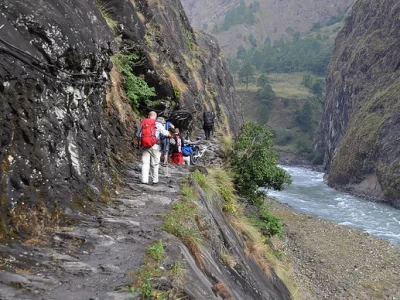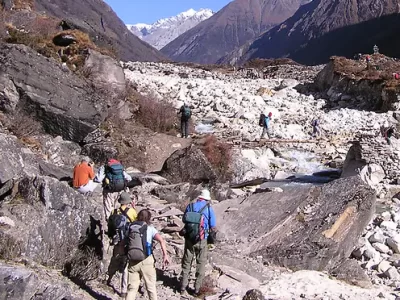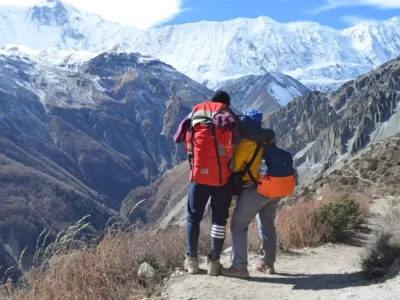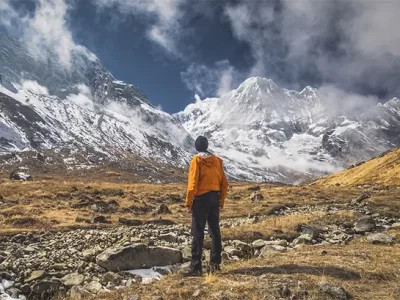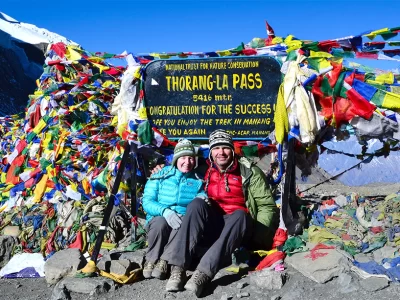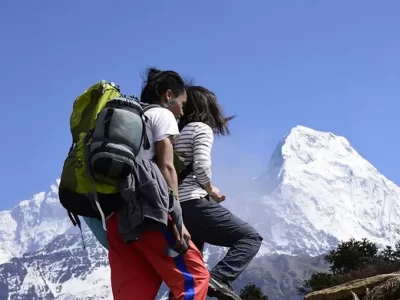The Tsum Valley trek immerses you in one of the most secluded and spiritually rich regions of Nepal. This trek from northern Nepal offers a beautiful and ancient view of the Tsum Valley for those eager to explore deep cultural connections and untouched nature. Tsum Valley Nepal is captivated by its enchanting remoteness and strong Tibetan cultural influences, which are evident in its architecture, religion, and daily life.
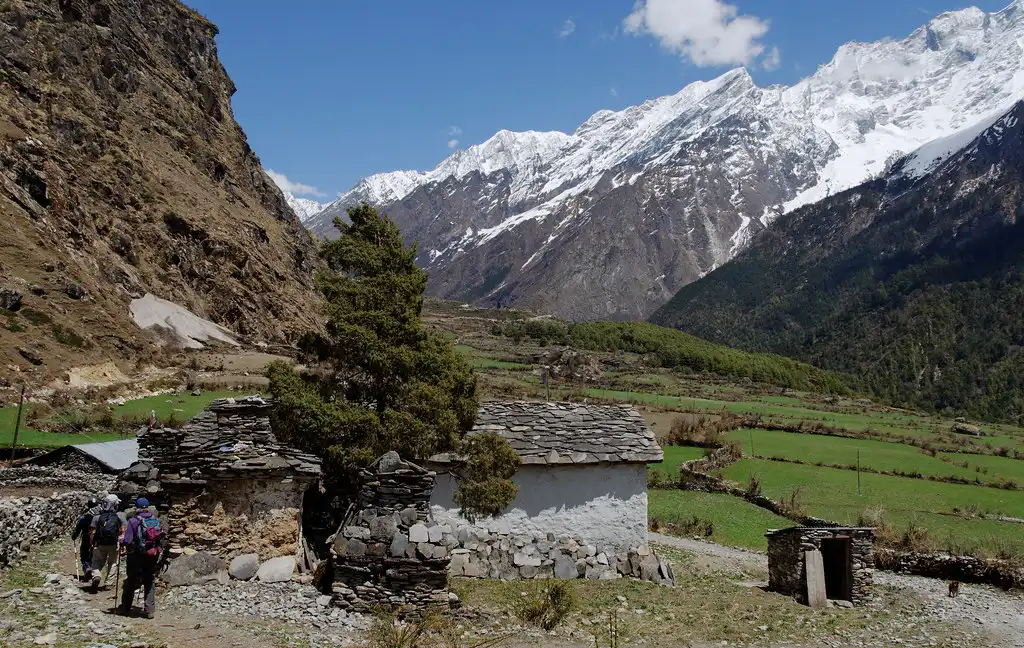
The Tsum Valley Trek takes you through ancient Buddhist monasteries such as Mu Gompa and Rachen Gompa, as well as past traditional villages that have preserved their rustic charm and traditions for generations. Encircled by the towering peaks of Ganesh Himal, Sringi Himal, and Boudha Himal, the trek offers mesmerizing views that enchant every traveler.
Major Highlights
- Mu Gompa: Delve into the history and tranquility of the ancient Mu Gompa monastery.
- Rachen Gompa: Explore the nunnery at Rachen Gompa, absorbing its unique cultural traditions.
- Ganesh Himal Views: Capture the breathtaking views of the Ganesh Himal mountain range.
- Chhokang Paro: Immerse yourself in the traditional Tibetan culture of the picturesque village of Chhokang Paro.
- Sringi Himal: Marvel at the imposing peaks of Sringi Himal that dominate the trek’s landscape.
- Local Homestays: Connect with local families through homestays and experience authentic hospitality and daily life.
The Manaslu and Tsum Valley Trek blends the rigors of high-altitude hiking with the cultural and spiritual richness of the Tsum Valley. The Tsum Valley Trekking Path forges a deep connection with both the natural and cultural landscapes. The Tsum Valley Trek itinerary includes visits to unique, secluded spots where you can engage with and learn from the local communities.
The Tsum Valley Trekking itinerary is structured to allow sufficient time for acclimatization and discovery, ensuring a profound and immersive experience that captures the tranquility and heritage of this extraordinary region.
Tsum Valley Trek
Manaslu Circuit Trek
Annapurna Circuit Trek
Tsum Valley Trek Itinerary
Day 1: Arrival in Kathmandu (1,400m)
You arrive in Kathmandu and transfer to your hotel from the airport. This day is essential for resting and acclimatizing after your flight. You might also explore some nearby sights in Kathmandu, depending on your energy levels.
Day 2: Kathmandu Sightseeing and Trek Preparation
You dive into the rich cultural tapestry of Kathmandu by touring significant historical sites like Pashupatinath, Boudhanath, Swayambhunath, and Kathmandu Durbar Square.
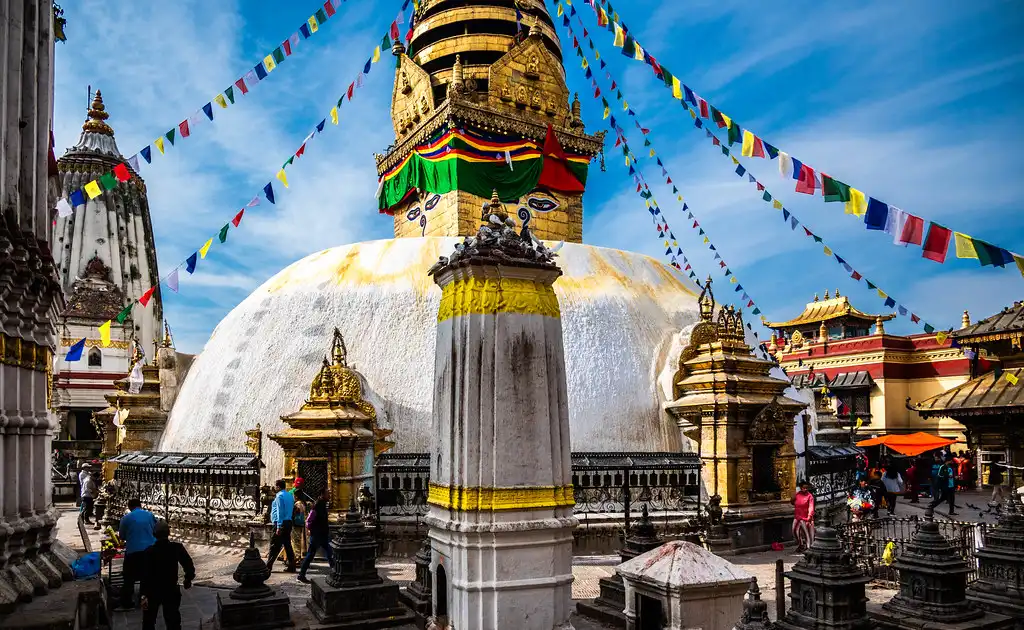
These landmarks offer insights into Nepal’s deep cultural and religious heritage. Concurrently, you’ll finalize your trekking permits and check your equipment with your trekking agency, ensuring you’re fully prepared for the trip ahead.
Day 3: Drive from Kathmandu to Soti Khola (600m, 7-8 hours)
You start the trip with a picturesque drive to Arughat Bazaar, then take a jeep to Soti Khola. As you travel through the Nepalese countryside and along mountain roads, the drive provides thrilling views. You’ll spend the night in Soti Khola, gearing up for the trek that commences the following day.
Day 4: Trek from Soti Khola to Machha Khola (1,300m, 6-8 hours)
On your first trekking day, you follow the Budhi Gandaki River. The trail meanders through lush forests, offering views of cascading waterfalls and a chance to soak in the hot springs at Tatopani.
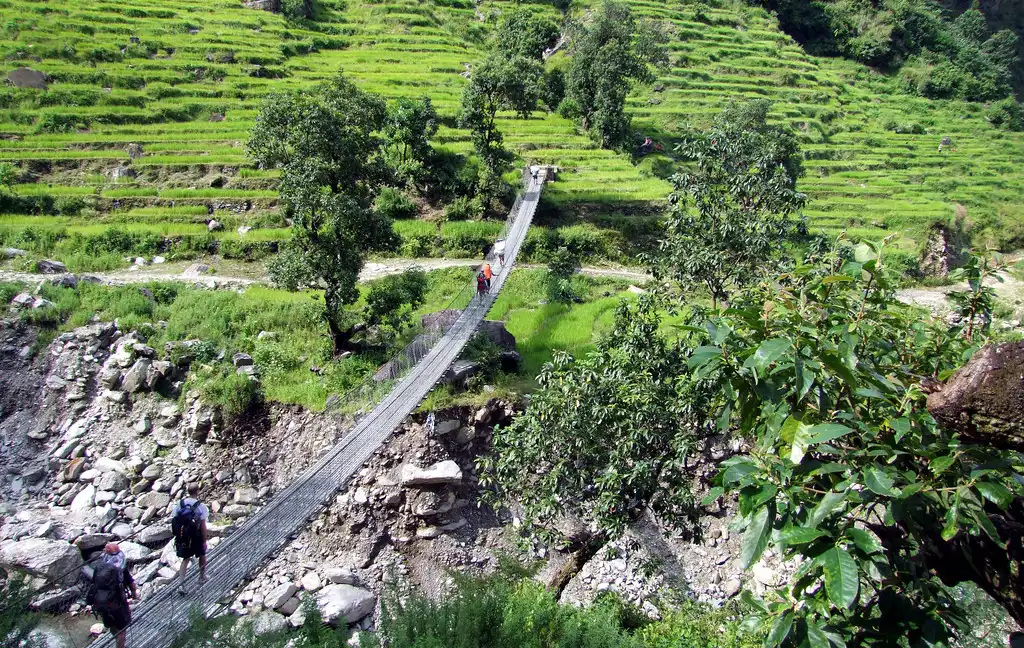
This spot is ideal for relaxing your muscles. Your day concludes at Machha Khola, where you’ll rest and spend the night.
Day 5: Trek from Machha Khola to Jagat (1,410m, 6-8 hours)
Continuing from Machha Khola, the trail leads to Jagat, a picturesque village noted for its flagstone streets and vibrant Mani walls. Jagat offers tranquil river views and a tranquil rural atmosphere, serving as a checkpoint for entry into the Manaslu Reserve. You will experience local hospitality overnight in Jagat, prepping for the climb into Tsum Valley the next day.
Day 6: Crossing the Budhi Gandaki River to Lokpa (2040m, 6-8 hours)
You’ll cross the Budhi Gandaki River and start your ascent towards Lokpa, serving as the entrance to Tsum Valley. This leg of the trek showcases stunning vistas of Manaslu and Ganesh Himal ranges. The path, offering a steady climb, introduces you to the solitude of Tsum Valley’s trails. You will spend the night in Lokpa, immersed in the peace of one of Nepal’s more secluded areas.
Day 7: Descending and Trekking to Chumling (2386m, 6-9 hours)
Today’s trek from Lokpa involves a descent back to the river valley followed by a steep climb to Chumling.
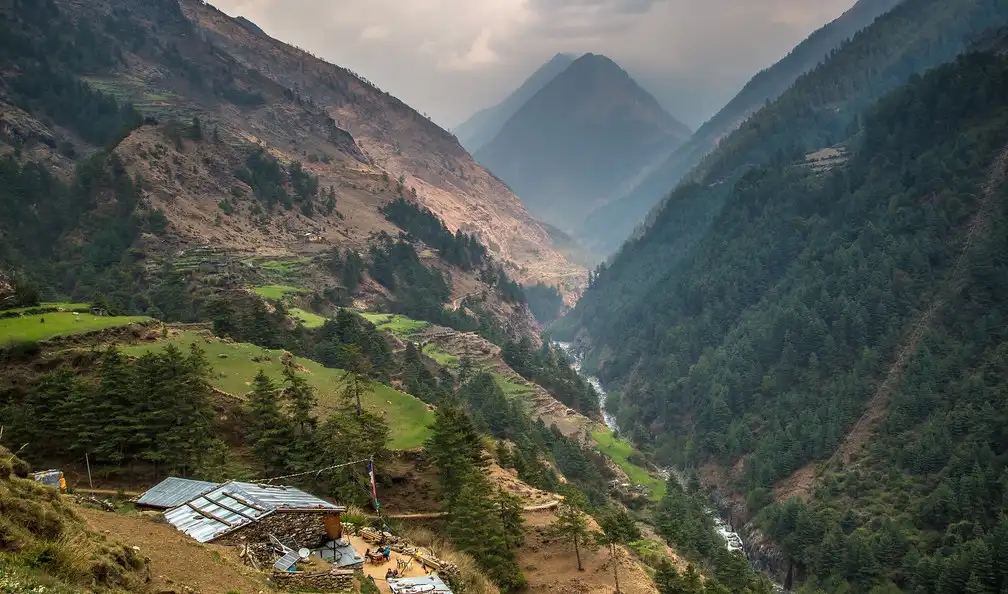
Chumling, known for its breathtaking Himalayan panoramas and rich culture, features traditional Tibetan-style architecture and monasteries. Staying overnight in Chumling offers a serene end to the day in this picturesque village.
Day 8: Venturing Deeper to Chhokangparo (3031m, 7-10 hours)
The trek progresses deeper into Tsum Valley as you head towards Chhokangparo. Today’s walk takes you to the higher sections of the valley, unveiling expansive fields and authentic villages set against the backdrop of the Himalayas. Chhokangparo, located at the convergence of the Siyar Khola, melds natural splendor with cultural richness, providing a memorable overnight stay.
Day 9: Moving from Chhokangparo to Nile (3361m, 4-6 hours)
As you leave Chhokangparo, you’ll pass through several traditional villages before reaching the Nile, the northernmost village before the Tibetan border. Along the way, visit Milarepa’s Cave, a significant historical site linked to the legendary Tibetan yogi. Overnight in the Nile offers a chance to rest and reflect on the cultural immersion and natural beauty experienced thus far.
Day 10: Short Trek to Mu Gompa (3700m, 3-4 hours)
A shorter trekking day leads you to Mu Gompa, an important monastery and spiritual center in the region.
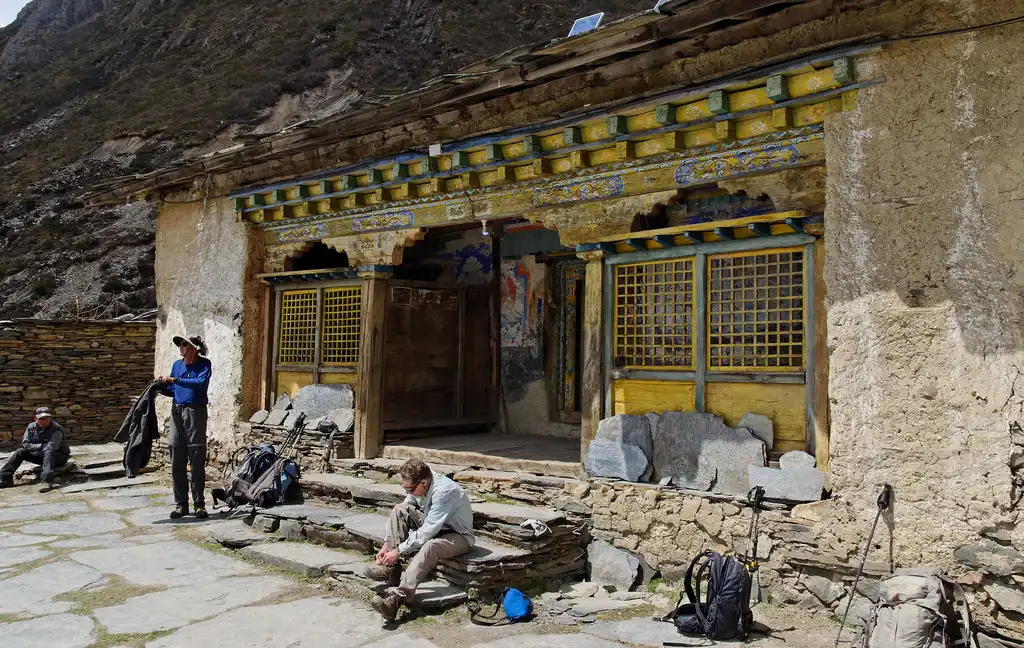
Staying overnight at Mu Gompa with the monks allows for a unique insight into the spiritual practices prevalent in this secluded part of the Himalayas, enhancing your connection to the region’s spiritual essence.
Day 11: Trek to Rachen Gompa (3240m, 3-4 hours)
From Mu Gompa, the trail leads to Rachen Gompa, another significant monastic site that acts as a spiritual haven for local nuns. The tranquil setting amidst the Himalayas makes Rachen Gompa an ideal spot for reflection. Spending the night here allows for deeper engagement with the local Buddhist traditions and practices.
Day 12: Trek to Gumba Lungdang (3200m, 8-12 hours)
Leaving Rachen Gompa, your next destination is Gumba Lungdang, trekking through remote and rugged parts of Tsum Valley. This part of the trek offers unparalleled views of Ganesh Himal and a profound sense of solitude.
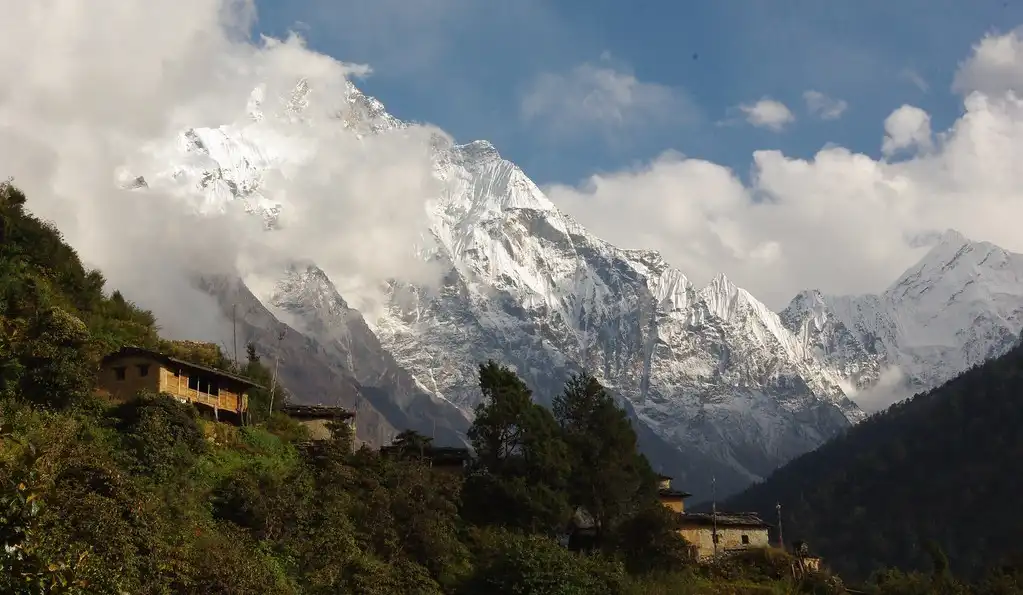
Overnight in Gumba Lungdang culminates a challenging day with a peaceful evening under the stars, surrounded by the raw beauty of the Himalayas.
Day 13: Retracing Steps from Gumba Lungdang to Lokpa (2240m, 7-10 hours)
You begin your descent from the spiritual retreat of Gumba Lungdang to Lokpa. This trek back offers a fresh perspective on the landscapes you passed earlier, revealing details that might have gone unnoticed. It’s a time for reflection and appreciation of the serene environment. You’ll spend the night in Lokpa, recuperating from the day’s trek.
Day 14: Descend from Lokpa to Jagat (1340m, 6-8 hours)
Your trek continues downward from Lokpa, exiting Tsum Valley and rejoining the well-trodden Manaslu Circuit path at Jagat. Transitioning from the isolation of Tsum Valley, you reacquaint yourself with the busier trails of the Manaslu region. Jagat, already familiar from your ascent, offers a comfortable stop for the night.
Day 15: Follow the Budhi Gandaki River from Jagat to Lapubensi (900m, 7-9 hours)
The trek takes you along the Budhi Gandaki River, where you cross multiple suspension bridges and enjoy the lush, dynamic river landscape one last time. This section is your final extensive trek through the lower Manaslu region’s rich environments. The day ends in Lapubensi, a quaint village where you can unwind and gear up for the trek’s conclusion.
Day 16: Final Trek from Lapubensi to Arughat (535m, 3-4 hours)
On the last day of your trek, you walk from Lapubensi to Arughat. This brief trip culminates with a jeep ride to Arughat, marking the end of your path through Tsum Valley and the Manaslu areas. Arughat reintroduces you to a more urban setting, celebrating the completion of your trek. You’ll enjoy local festivities or a special dinner to celebrate this milestone.
Day 17: Return to Kathmandu
You board a bus to Kathmandu after completing your enriching trek in Tsum Valley. This trip allows you to unwind and reflect on the unforgettable moments and accomplishments of your trek.
Upon arrival in Kathmandu, a farewell dinner celebrates the end of your Himalayan adventure. This meal, featuring traditional Nepalese dishes, provides an opportunity to exchange stories with fellow trekkers. They serve you breakfast, lunch, and dinner throughout the day, ensuring a smooth reentry to urban life.
Day 18: Departure
After a transfer to the airport for your flight out, your experience comes to an end. While this day marks the end of your time in Nepal, the memories and insights from Tsum Valley will resonate long after you’ve returned home. A final Nepalese breakfast bids you farewell, encapsulating the hospitality you’ve experienced throughout the trip.
Annapurna Base Camp Trek
Mini Annapurna Circuit Trek
Ghorepani Poon Hill Trek
Best Time to Trek
Spring (March to May)
Springtime in Tsum Valley ushers in a season of renewal and vibrant landscapes, making it a favored period for trekking. The temperate weather during these months creates ideal conditions for hiking and exploration.
Weather Conditions: The valley experiences a warming trend as winter fades, with daytime temperatures ranging from 5°C to 17°C. However, nighttime temperatures at higher elevations can dip below freezing. Generally, the weather remains stable, providing clear skies and excellent visibility of the Himalayan peaks.
What to Expect: With the arrival of spring, the valley and its lower slopes burst into color with blooming rhododendrons and wildflowers. This floral display not only beautifies the trails but also attracts diverse wildlife, enriching the trekking experience. Trails mostly stay dry, though there might be occasional showers as summer approaches. This season is a boon for photographers and nature lovers eager to capture the valley in full bloom.
Autumn (September to November)
Autumn stands shoulder to shoulder with spring as a prime time for trekking in Tsum Valley, favored for its stable weather and unmatched clarity in mountain views.
Weather Conditions: The post-monsoon climate brings fresh air and crystal-clear skies. Daytime temperatures make for comfortable trekking, typically stabilizing between 8°C and 16°C. As winter approaches, nights grow colder, especially at higher altitudes where temperatures can plunge below freezing.
What to Expect: Autumn also marks the harvest season, adding a layer of cultural vibrancy to the valley. Fields ripen into a golden hue, ready for harvest. The clear, dust-free skies post-monsoon enhance mountain visibility. Trekking during this season offers not only favorable conditions but also a glimpse into local agricultural practices and festive harvest celebrations.
Accommodation and Meals
While trekking through Tsum Valley, you’ll primarily stay in teahouses operated by local families. These provide basic yet cozy accommodations, often featuring shared bathroom facilities and twin-bedded rooms.
Given the valley’s remoteness, amenities tend to be simpler compared to those found on more popular treks like Everest Base Camp or the Annapurna Circuit. However, some teahouses, especially the newer or recently refurbished ones, may offer private rooms and hot showers for an extra charge.
The cuisine on the Tsum Valley trek focuses on hearty, energy-rich meals ideal for the demands of trekking. A typical meal is the Nepali “dal bhat,” a generous serving of lentil soup, rice, vegetable curry, and occasionally meat, which teahouses will replenish at no extra cost.
Other common dishes include Tibetan bread, momos (dumplings), various noodle dishes, and different potato preparations. Breakfasts usually consist of porridge, Tibetan bread with jam or honey, and eggs, accompanied by a selection of hot beverages like tea, coffee, and hot chocolate.
Preparing for the Trek
Physical Fitness and Training Tips
To ensure a successful Tsum Valley trek:
- Start conditioning your body at least 8-12 weeks in advance.
- Focus on enhancing your cardiovascular endurance through running, cycling, and swimming.
- Simulate trek conditions by hiking with a weighted backpack, gradually increasing the weight and hike duration.
- Include regular stretching and flexibility exercises to prevent injuries and improve your mobility.
Essential Permits and Paperwork
It would be best if you secured several permits before you can trek in Tsum Valley:
Tsum Valley Restricted Area Permit (RAP): Obtainable only through a registered trekking agency in Nepal, this permit is essential for accessing the valley.
Manaslu Conservation Area Permit (MCAP): This is required since the trek passes through this conservation area.
TIMS Card (Trekkers’ Information Management System): Available from trekking agencies or the Nepal Tourism Board, this card ensures trekker safety.
Essential Packing List
Clothing
- Base Layers: Opt for moisture-wicking shirts and thermal underwear.
- Insulating Layers: Include fleece jackets and down jackets.
- Trekking Pants and Shirts: Bring comfortable, quick-drying pants and both long and short-sleeved trekking shirts.
- Headwear and Gloves: Remember a warm hat, gloves, a sun hat, and sunglasses.
- Socks: Pack several pairs of moisture-wicking and wool socks, along with gaiters.
Gear
- Backpack: Choose a durable, comfortable backpack with a rain cover.
- Sleeping Bag: Ensure it’s rated for -10°C or lower.
- Trekking Poles: Adjustable poles are helpful.
- Headlamp: Include extra batteries.
- Hydration: Bring water bottles and a hydration system, aiming for a minimum capacity of 2-3 liters. Include water purification tablets or a filter.
Essentials
- First Aid Kit: Stock it with blister treatment, bandages, antiseptic wipes, and your medications.
- Hygiene Items: Pack biodegradable soap, toothbrush, toothpaste, and toilet paper.
- Snacks: Bring energy bars, nuts, and dried fruits.
- Electronics: Remember your camera, phone, chargers, and power banks.
- Navigation Tools: Carry a map, compass, or GPS device.
- Cash and Documents: Bring cash in small denominations and copies of your passport, permits, and travel insurance.
Tsum Valley Trek Cost
The Tsum Valley trek cost depends on factors such as the trekking agency, trek duration, and the season. Typically, an 18-day trek package costs between USD 1,800 and USD 2,200. This all-inclusive price usually covers permits, accommodations, meals, a guide, porters, and transportation.
During peak seasons like spring and autumn, prices may increase due to higher demand. In addition to the package cost, trekkers should budget for personal expenses like trekking gear, tips for guides and porters, extra snacks, and bottled water.
Essential permits, including the Tsum Valley Restricted Area Permit (USD 40 per person per week in autumn and USD 30 per person per week in other seasons) and the Manaslu Conservation Area Permit, are also covered in the Tsum Valley trek cost. Proper budgeting for these additional expenses ensures a seamless trekking experience.
Tsum Valley Trek Map
The Tsum Valley trek map outlines the entire trekking route in detail, showcasing key points of interest, altitude changes, and significant landmarks. Starting from Soti Khola, the map guides trekkers through important villages like Chumling, Chhokangparo, and Mu Gompa.
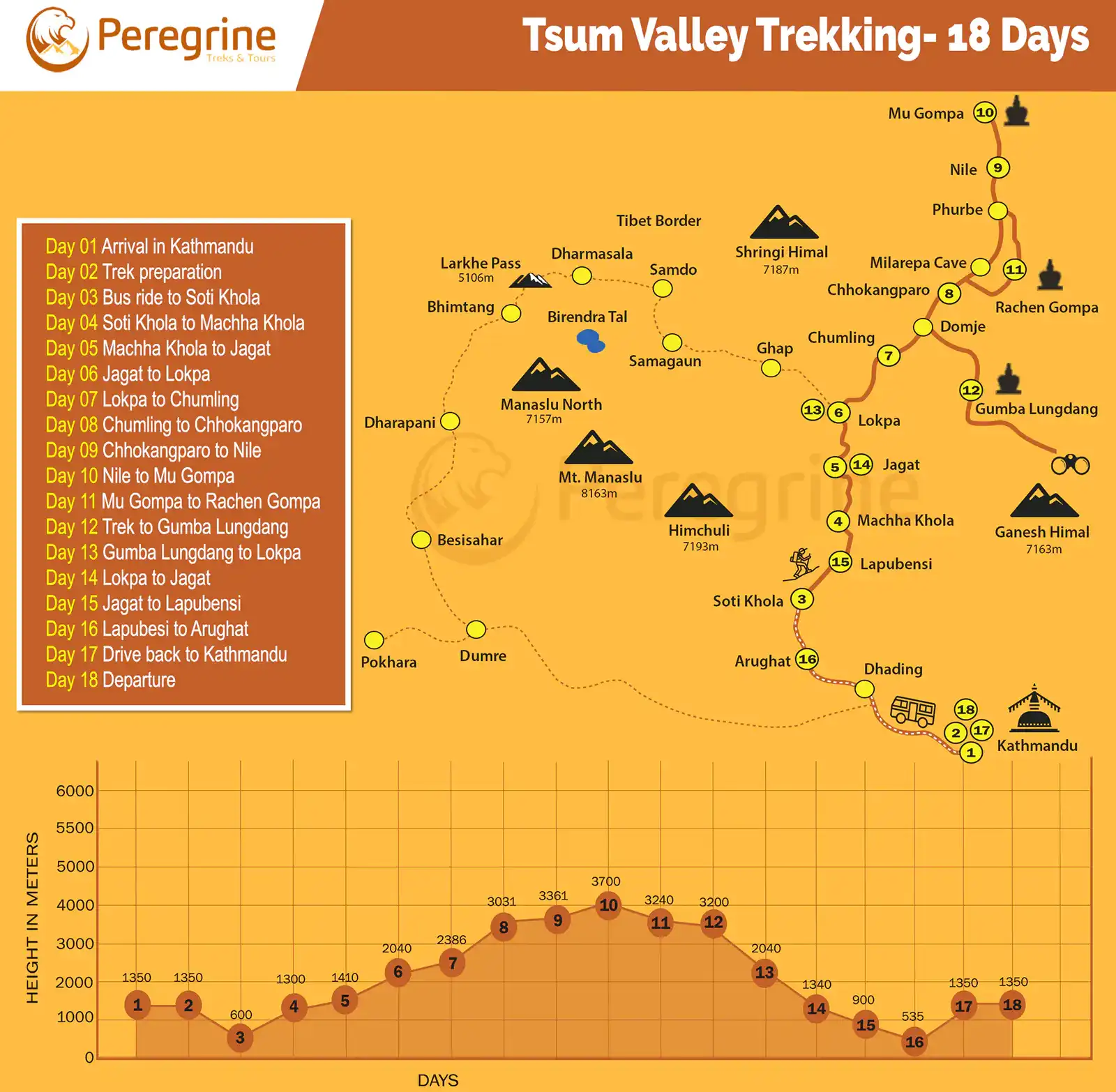
This map is essential for planning daily treks, helping trekkers anticipate challenging sections, and fully appreciating the scenic vistas of Tsum Valley. Using a Tsum Valley trek map is vital for navigating the remote, less-traveled paths of the area.
It aids in route planning and enhances safety by indicating the locations of teahouses, water sources, and emergency evacuation points. Trekkers can rely on the map to better understand the cultural and geographical highlights, making their trek more enriching and informed.
Tsum Valley Trek from Kathmandu
The Tsum Valley trek from Kathmandu starts with a picturesque drive to Soti Khola, which serves as the trek’s starting point. This drive, lasting approximately 7-8 hours by bus or jeep, showcases the diverse landscapes and rural life of Nepal. Upon reaching Soti Khola, trekkers begin a multi-day trek through lush forests, traditional villages, and breathtaking mountain vistas. Each day involves several hours of trekking, with overnight stays in teahouses along the route.
The trek seamlessly blends natural beauty with cultural immersion, passing through notable sites such as Chumling, Chhokangparo, and Mu Gompa. During the Tsum Valley trek from Kathmandu, trekkers immerse themselves in the unique Tibetan-influenced culture of the Tsum Valley.
The trek offers opportunities to visit ancient monasteries, engage with local communities, and relish the serene, untouched landscapes of this remote region. The trek concludes with a return trek to Soti Khola and a drive back to Kathmandu, completing an adventure that combines physical challenges with deep cultural experiences.
Tsum Valley Trek Distance
The Tsum Valley trek distance spans approximately 170 kilometers (106 miles) round trip. Trekkers traverse a variety of landscapes, including lush forests, terraced fields, traditional villages, and high-altitude terrains. The trip begins at Soti Khola and passes through key locations like Chumling, Chhokangparo, and Mu Gompa.
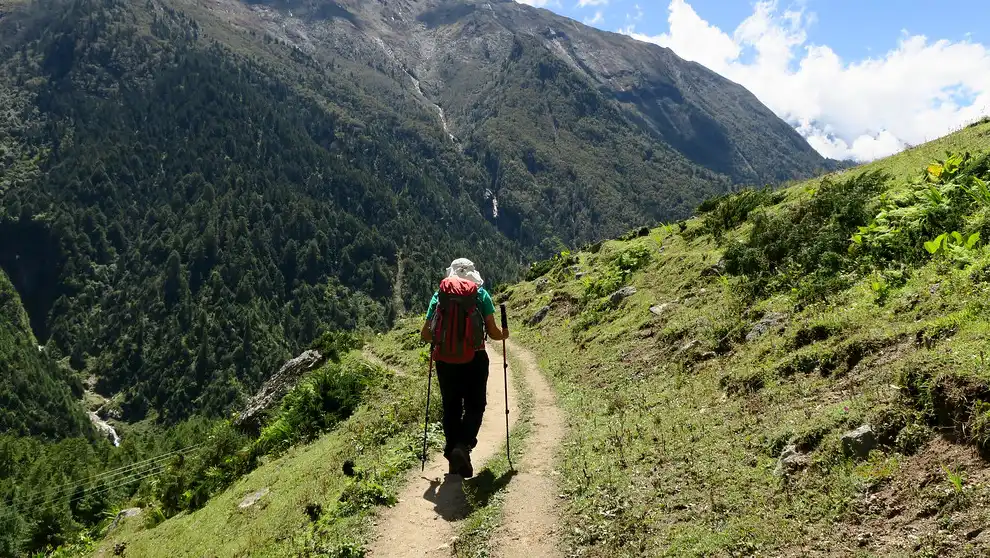
Each day involves hiking distances that typically range from 10 to 20 kilometers, allowing trekkers to experience the diverse beauty of the region. Considering the Tsum Valley trek distance, the entire trek usually takes between 18 to 21 days to complete, depending on the pace and specific itinerary.
This timeframe includes acclimatization days, ensuring trekkers adjust to the altitude changes. The trek’s varied distances and elevations require good physical fitness and preparation, making it essential for trekkers to train adequately for an enjoyable and safe adventure.
What to Expect on the Trek
The Tsum Valley trek offers a diverse range of terrains and trail conditions ideal for both adventure and exploration. The trek begins amidst lush forests and terraced fields near Soti Khola, gradually transitioning to rugged paths and rocky terrain as you ascend through the valley.
Along the way, the trails wind through traditional villages like Chumling and Chhokangparo, providing glimpses into local life and cultural heritage set against the majestic backdrop of towering Himalayan peaks. Nature enthusiasts will find themselves captivated by the wildlife and natural scenery that abound along the Tsum Valley trek.
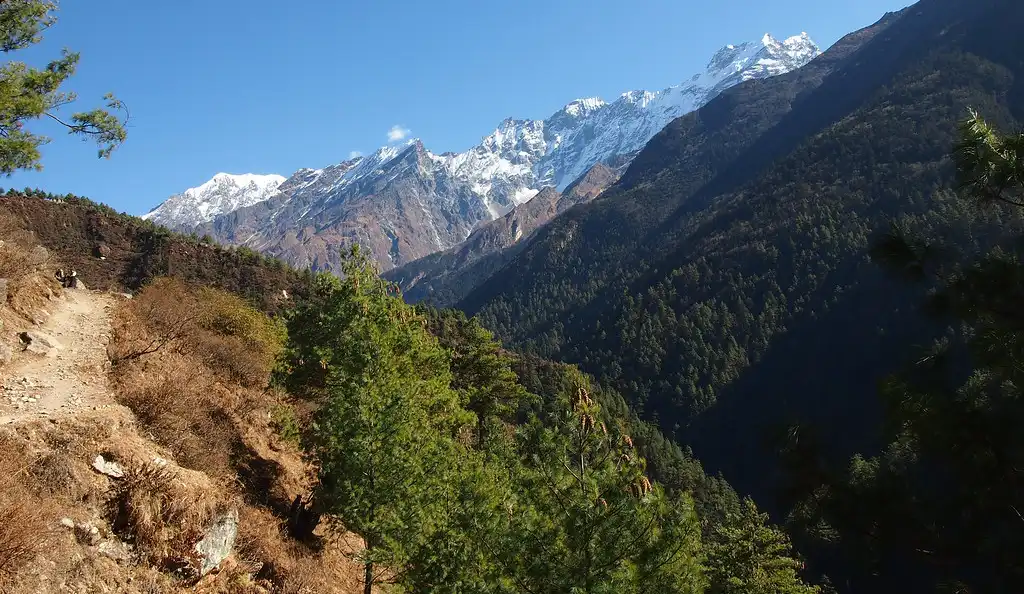
Keep a keen eye out for Himalayan wildlife such as Himalayan Thars, Musk Deer, and a variety of bird species. The landscape evolves from verdant forests to picturesque alpine meadows adorned with vibrant rhododendrons during spring, offering breathtaking vistas of snow-capped peaks like Ganesh Himal and Manaslu.
The untouched beauty of Tsum Valley, accentuated by fluttering prayer flags in the wind, creates a serene and spiritually uplifting ambiance. The Tsum Valley trek presents both challenges and rewards for trekkers. Expect steep ascents, rocky trails, and high altitudes that demand good physical fitness and proper acclimatization.
Yet, overcoming these challenges brings a profound sense of accomplishment and unparalleled views that few have the privilege to witness. Engage with local communities, explore ancient monasteries such as Mu Gompa, and observe daily life in remote villages to gain a deeper cultural insight. Each day unveils new landscapes and cultural encounters, ensuring the Tsum Valley trek is a memorable and enriching trip deep into the heart of the Himalayas.
Tsum Valley Trek Difficulty
Trekkers who are physically active and have some prior trekking experience are best suited for the Tsum Valley trek, which ranges in difficulty from moderate to tough. Daily treks last 5-7 hours and cover varied terrains, including steep ascents, rocky paths, and river crossings.
Although the altitude gain is gradual, proper acclimatization is essential to prevent altitude sickness, especially as trekkers approach elevations over 3,700 meters (12,140 feet) at Mu Gompa. Despite its challenges, the trek remains accessible with adequate preparation. Trekkers should focus on building cardiovascular fitness, strength, and endurance before the trip.
Experience in high-altitude trekking is beneficial but optional. The trail offers a blend of strenuous and manageable segments, allowing for rest and recovery. Maintaining a steady pace, staying hydrated, and acclimatizing properly are crucial for managing the trek’s difficulty and ensuring a safe and enjoyable adventure through the culturally rich and remote Tsum Valley.
Frequently Asked Questions
1. How many days is the Tsum Valley trek?
The Tsum Valley trek typically spans about 16 to 18 days, depending on your chosen itinerary and hiking pace. This duration allows ample time for acclimatization and exploration of the remote and culturally rich Tsum Valley region in Nepal.
You are starting from Soti Khola. The trek passes through charming towns like Chumling, Chhokangparo, and Mu Gompa, giving hikers a chance to experience the area’s natural beauty and Tibetan-influenced culture fully. Because of the trek’s length, you may gradually acclimate to the altitude while enjoying the peaceful landscapes, touring historic monasteries, and admiring the breathtaking views of the Himalayas.
2. How do I get to Tsum Valley?
To reach Tsum Valley, start your trip from Kathmandu, Nepal’s capital. A scenic drive of approximately 7-8 hours takes you to Soti Khola, the trek’s starting point. In order to get to Arughat Bazaar and then Soti Khola, tourists can take a local bus or rent a private jeep from Kathmandu.
This road trip offers glimpses of Nepal’s diverse landscapes, rural life, and winding mountain roads. It’s advisable to plan your transportation, especially during peak trekking seasons like spring and autumn, to ensure availability and travel comfort.
3. How much is the Manaslu Tsum Valley trek?
The cost of the Manaslu Tsum Valley trek varies according to a number of criteria, including the season you travel in, the length of your trek, the services you include, and the trekking agency you choose. Typically, an 18-day package for the Manaslu Tsum Valley trek ranges from USD 1,800 to USD 2,200 per person.
This price usually covers essential services such as permits, accommodations in teahouses, meals, guide services, porters, and round-trip transportation from Kathmandu. Additional expenses may include personal trekking gear, tips for guides and porters, extra snacks, and bottled water. Budgeting for necessary permits like the Tsum Valley Restricted Area Permit and the Manaslu Conservation Area Permit ensures a smooth trekking experience.
4. What is the altitude of Tsum Valley?
Nestled between the Ganesh Himal range and the Budhi Gandaki River, Tsum Valley lies in the northern region of Nepal’s Gorkha district. Along the trekking route, altitudes vary, with lower areas starting around 1,900 meters (6,233 feet) and higher points reaching over 3,700 meters (12,140 feet) at Mu Gompa.
These altitudes offer trekkers a diverse landscape experience, from lush forests and terraced fields to alpine meadows and snow-capped peaks. Proper acclimatization and a gradual ascent are essential to manage altitude-related challenges and enjoy the trek safely.
5. How much is the bus ticket from Kathmandu to Machha Khola?
The bus ticket from Kathmandu to Machha Khola, a village near the starting point of the Tsum Valley trek, costs approximately NPR 1,000 to NPR 1,500 per person (about USD 8 to USD 12). Driving the 140 kilometers (87 miles) required takes about 7 to 8 hours.
Buses depart Kathmandu early in the morning, passing through scenic rural areas and across river crossings. To secure seats and ensure a comfortable trip to the trek’s starting point, you should purchase tickets in advance, particularly during the busiest trekking season.
6. What is the history of Tsum Valley?
Tsum Valley holds significant cultural and historical importance in Nepal. Historically, Tsum Valley served as a vital trade route between Tibet and Nepal, fostering cultural exchanges and influencing the region’s unique Tibetan-influenced culture. Over time, Tsum Valley remained isolated from mainstream development and modernization, preserving its ancient monasteries, traditions, and landscapes.
The valley is home to several Buddhist monasteries, including Rachen Gompa and Mu Gompa, which have served as centers of religious learning and meditation for centuries. Today, Tsum Valley attracts trekkers seeking to explore its rich history, serene environment, and spiritual heritage amidst the majestic Himalayan mountains.
Conclusion
The Tsum Valley Trek, with its breathtaking scenery, vibrant culture, and difficult paths, provides an unforgettable experience. You will immerse in breathtaking landscapes, spot diverse wildlife, and engage with the vibrant local communities, all framed by the majestic Himalayas.
If you are planning this trek, prepare yourself physically and mentally for high-altitude challenges. Respect local customs, acclimate gradually, and savor every moment of this remarkable trek.

